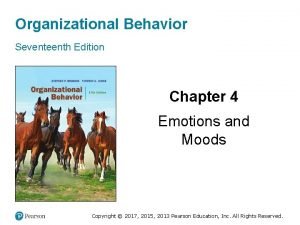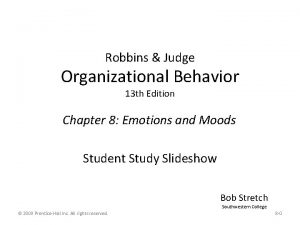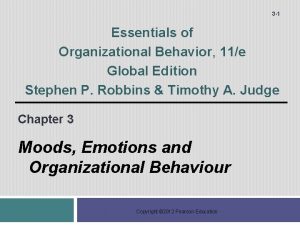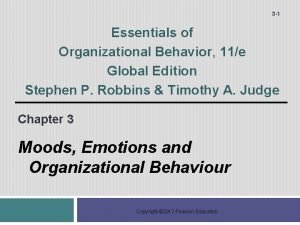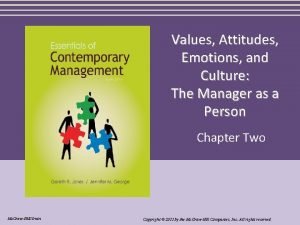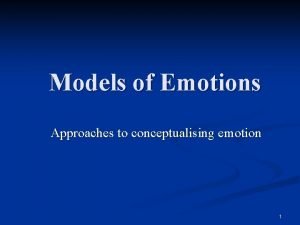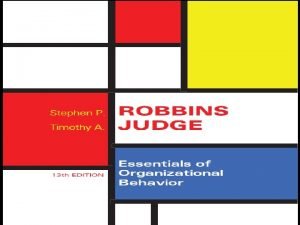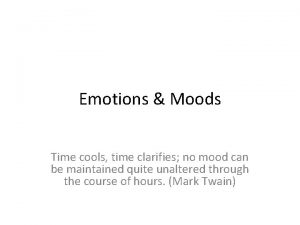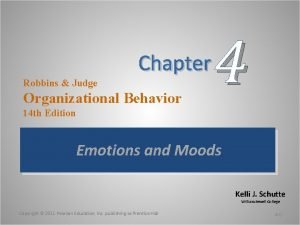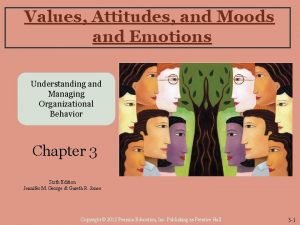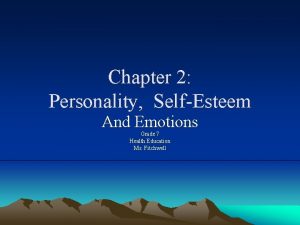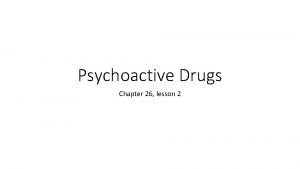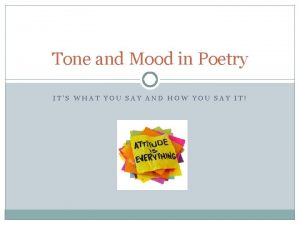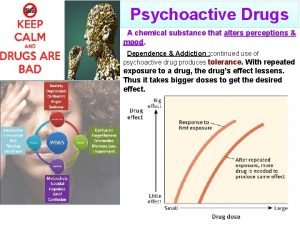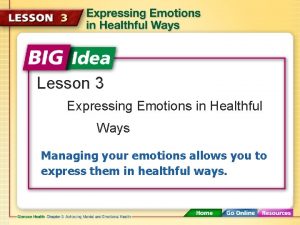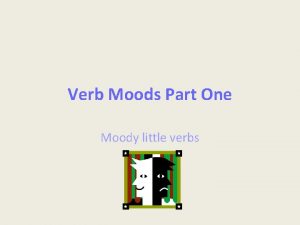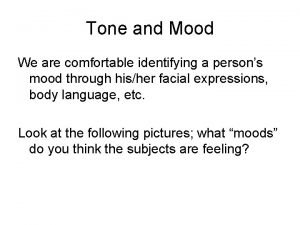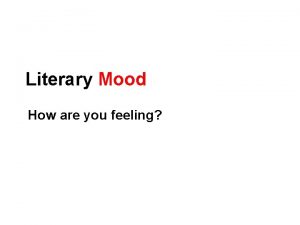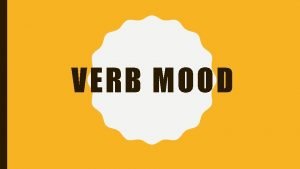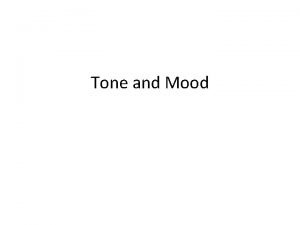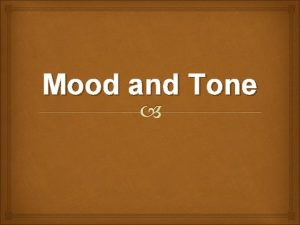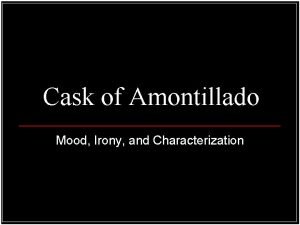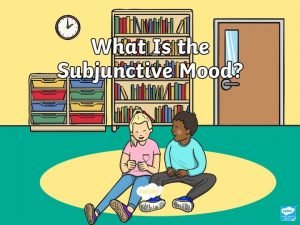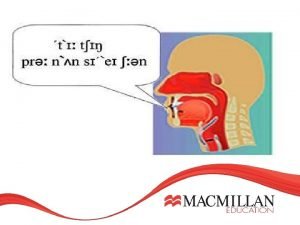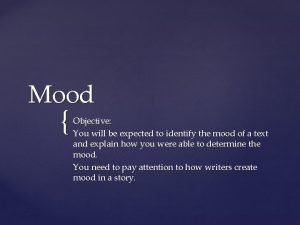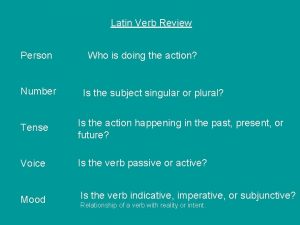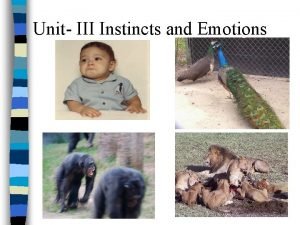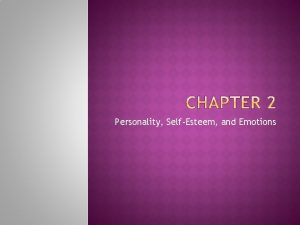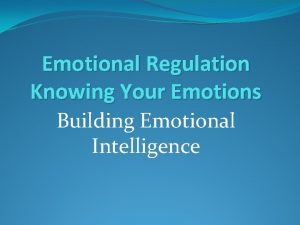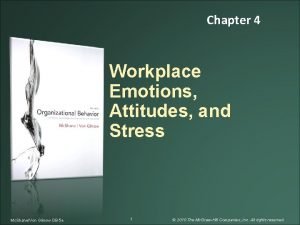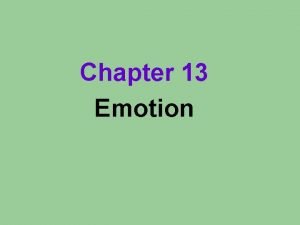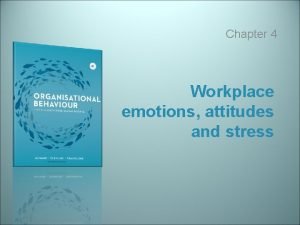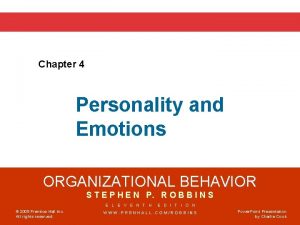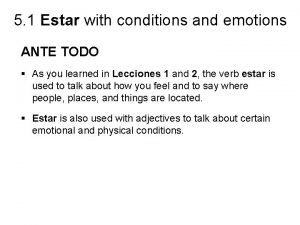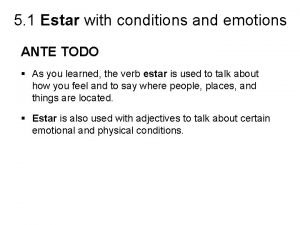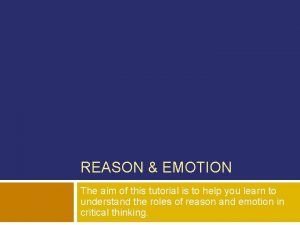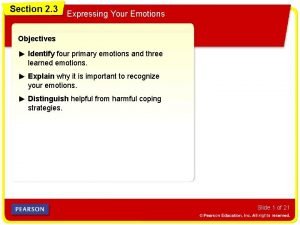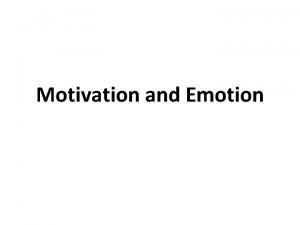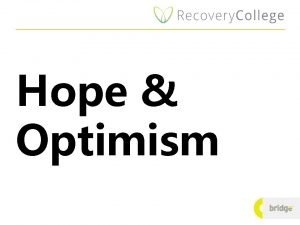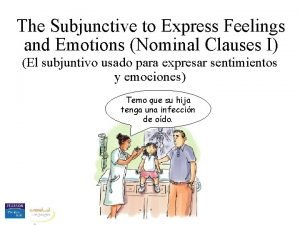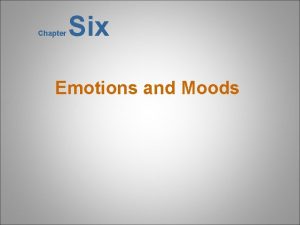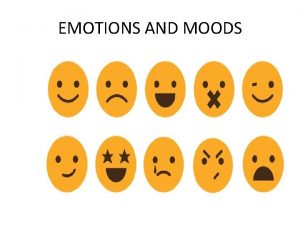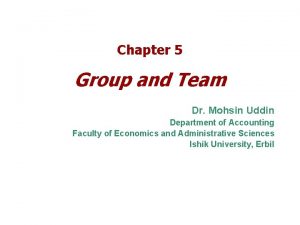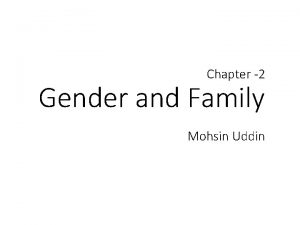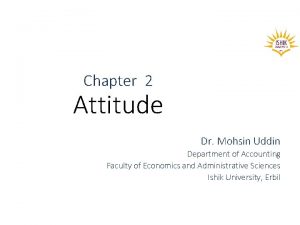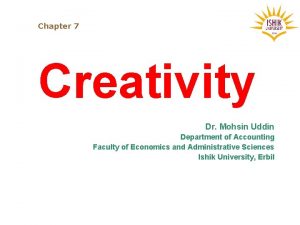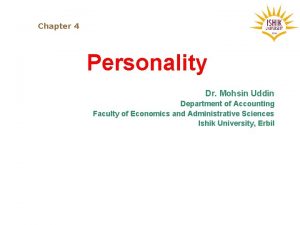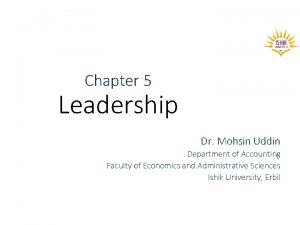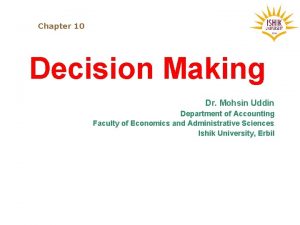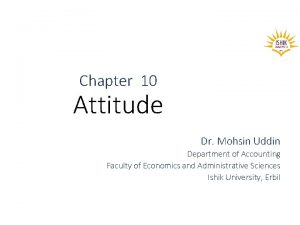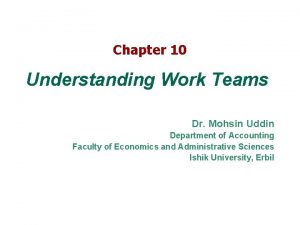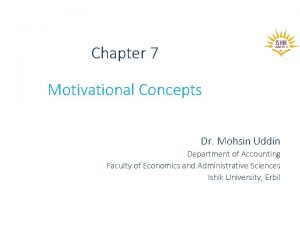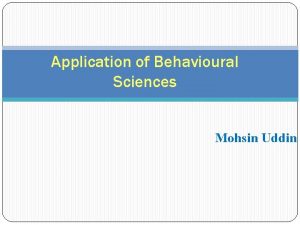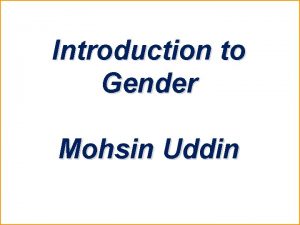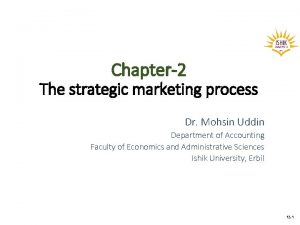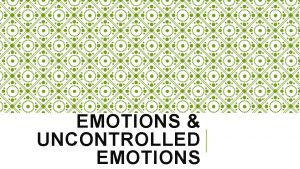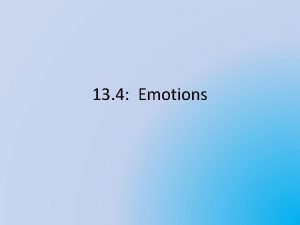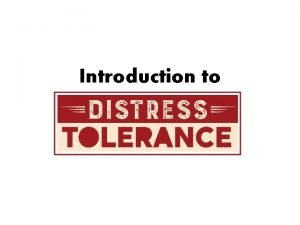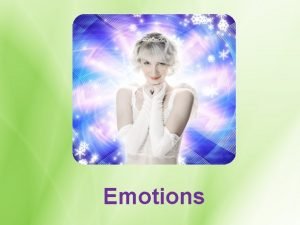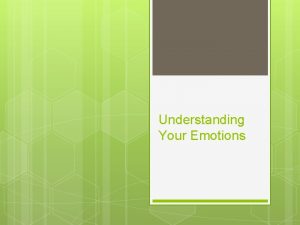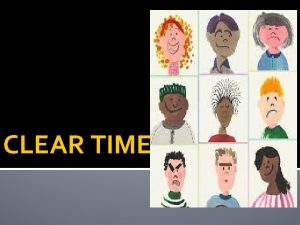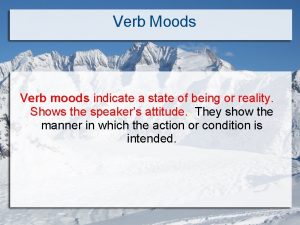Chapter 4 Emotions and Moods Dr Mohsin Uddin


























































- Slides: 58

Chapter 4 Emotions and Moods Dr. Mohsin Uddin Department of Accounting Faculty of Economics and Administrative Sciences Ishik University, Erbil

EMOT I NS AND M DS

Learning Outcomes • Understand what emotions are and distinguish between affect, mood and emotions • Explain the functions of emotions (why do we experience emotions? ) • Explain the various ways in which emotions have an impact in the workplace Organisational Behaviour, edited by Christine Cross and Ronan Carbery ©Palgrave, Macmillan 2016

Learning Outcomes • Identify the impact that ‘emotion work’ has on employees • Learn ways in which employees can effectively manage their emotions in the workplace Organisational Behaviour, edited by Christine Cross and Ronan Carbery ©Palgrave, Macmillan 2016

What is Affect? Affect is a broad range of feelings that people experience.

Affe ct Emotions Moods

• The term 'emotion' is derived from the Latin word ‘emovere’ which means to agitate, excite or move. • Emotions are generally referred to as a moved up condition involving personal experience and affective reactions. • They may be pleasant or unpleasant. Pleasant emotions are the sources of joy whereas unpleasant emotions are related to disturbing mental states like aggression, fear, anxiety etc.

What are emotions and moods? Emotions are strong feelings that are directed at someone or something. Moods are feelings that tend to be less strong than emotions


Duratio n Emotions are very brief (seconds or minutes) Moods lasts longer than emotions(hours or days)

Orientatio n Emotions are Action oriented. Moods are cognitive in nature.

Action Emotions are caused by specific event. Cause of mood is often general & unclear.

Expressi on Emotions are accompanied by different facial expression. Moods are generally not indicated by different expressions.

Dimensi on • Emotions are specific & several in nature. • Moods have only two dimension ; i. e. , Positive effect or Negative Effect.

Felt Emotions An individual’s actual emotions. Example— Yuvraj Singh had tears of happiness immediately after winning the World Cup.

Displayed Emotions that are organizationally required and considered appropriate in a given job.

Displayed Emotion

Surface Acting Hiding one’s inner feelings and forgoing emotional expressions in response to display rules.

Surface Acting A car salesman is hiding his ‘anger’ towards a customer who had long test drive and still does not purchase the car. Still the Car Salesman smiles and says ‘Come Again Sir. . !!’

Deep Acting Trying to modify one’s true inner feelings based on display rules.

FACTORS AFFECTING EMOTIONS

• PERSONALIT Y • CULTUR E

• WEATHER • STRES S

• AG E • GENDER

• ENVIRONMENTA L

• ORGANIZATIONA L • SOCIAL

EMOTIONAL INTELLIGEN CE

EMOTIONAL Emotional intelligence (EI) refers to the ability to INTELLIGENCE perceive, control and evaluate emotions.

FOUR BRANCHES Salovey and Mayer proposed a model that identified four different factors of emotional intelligence

to accurately perceive them. In many cases, this might involve understanding nonverbal signals such as body language and facial expressions.

The next step involves using emotions to promote thinking and cognitive activity. Emotions help prioritize what we pay attention and react to; we respond emotionally to things that garner our attention.

Understanding Emotions: The emotions that we perceive can carry a wide variety of meanings. If someone is expressing angry emotions, the observer must interpret the cause of their anger and what it might mean.

Managing Emotions: The ability to manage emotions effectively is a key part of emotional intelligence. Regulating emotions, responding appropriately and responding to the emotions of others are all important aspect of emotional management.

What are emotions and moods? Emotions “I was really angry when Prof. Nitpicker criticized my presentation” • Identified with a source, cause • Tend to be brief, episodic • Many forms and types • Action oriented; link to behavior • Can turn into a mood Moods “Oh, I just don’t have the energy to do much today. I’ve felt down all week. ” • Hard to identify cause • Can be long lasting • Either positive or negative • More cerebral; less action oriented • Can influence emotion Copyright © 2008 John Wiley & Sons, Inc. 3 -34

Why do we have emotions? What function do they serve? • Emotions are a source of information • Emotions play a role in preparing our behavioural responses, tuning our decisionmaking, enhancing our memory for important events and facilitating our interpersonal interactions Organisational Behaviour, edited by Christine Cross and Ronan Carbery ©Palgrave, Macmillan 2016

Emotions in the workplace • Emotions have been shown to play a role in performance, decision-making, creativity, group dynamics and individual behaviours • When considering the role of emotions in the workplace, it is also important to distinguish between the expression and experience of emotions at work Organisational Behaviour, edited by Christine Cross and Ronan Carbery ©Palgrave, Macmillan 2016

Managing emotions in the workplace • Emotion regulation refers to the set of processes whereby people manage their emotional states, including specific emotions such as anger or sadness, moods such as depression and euphoria, general stress responses and rapid affective reactions that may or may not be consciously experienced • Basic components of emotion regulation include recognition and understanding of one’s own emotions, managing these emotions by inducing, modulating or preventing them, and using emotions for action and goal attainment (Pekrun 2006) • Individuals must be aware of their current emotional state and the possible consequences an emotion has, both for themselves and for others (Niedenthal et al. 2006) Organisational Behaviour, edited by Christine Cross and Ronan Carbery ©Palgrave, Macmillan 2016

Managing emotions in the workplace Emotion regulation has links to the concept of emotional intelligence (EI) Salovey, Hsee, and Mayer (1993) introduce EI as referring to three inter-related skills or abilities: – accurate appraisal of mood and expression of emotion by oneself and others, – adaptive regulation of emotion in self and others, – utilizing emotions (e. g. in problem solving) Organisational Behaviour, edited by Christine Cross and Ronan Carbery ©Palgrave, Macmillan 2016

Managing emotions in the workplace Goleman’s (1995) approach to emotional intelligence assesses 20 competencies, subsumed under four clusters: – Self-awareness – Self-management – Social awareness – Social skills Organisational Behaviour, edited by Christine Cross and Ronan Carbery ©Palgrave, Macmillan 2016

Managing emotions in the workplace • Petrides (2011) provides clear distinctions between ability emotional intelligence and trait emotional intelligence – Ability emotional intelligence can be described as one’s ability to monitor one’s own and others’ feelings and emotions, and to use this information to guide one’s thinking and actions (Salovey and Mayer 1990) – Trait emotional intelligence concerns emotion-related selfperceptions, which is similar to a type of trait emotional selfefficacy (Petrides 2011) • Trait emotional intelligence is thus more accurately classified as personality, while ability emotional intelligence is theoretically within the domain of cognitive ability Organisational Behaviour, edited by Christine Cross and Ronan Carbery ©Palgrave, Macmillan 2016

Strategies for managing emotions • Two of the most common ways of managing emotions are to – reappraise our emotions – suppress our emotions • Reappraisal is a form of cognitive change, and begins with the idea that no situation in and of itself generates an emotion. It is the individuals’ appraisal of the situation that does so – Reappraisal is an antecedent-focused strategy because one intervenes before an emotion has been fully generated, and hence, can efficiently alter the entire subsequent emotional experience (Gross and John 2003) – Beal et al. (2006) argue that the deep acting is a form of regulation that is typically achieved through cognitive reappraisal of the events surrounding the emotional experience Organisational Behaviour, edited by Christine Cross and Ronan Carbery ©Palgrave, Macmillan 2016

Strategies for managing emotions • Suppression refers to inhibiting the expression of emotion (Gross, 1999) – It is a response-focused strategy, and modifies the behavioural aspect of emotion response tendencies – It requires individuals to exert effort to manage emotional expressions as they arise, and this effort may consume cognitive resources that could otherwise be used for optimal performance • Gross (1998) found that reappraisal is more effective than suppression – Reappraisers cope with stress by using reinterpretation, have a welldeveloped ability for negative mood repair, and show a capacity for negative mood regulation. Furthermore, reappraisers tend to experience and express greater positive emotion Organisational Behaviour, edited by Christine Cross and Ronan Carbery ©Palgrave, Macmillan 2016

Why Were Emotions Excluded from • Myth of rationality – OB Study? emotions should not be seen in the workplace • Belief that emotions of any kind are disturbing in the workplace 3 -43

Affect – Emotions – Mood!! • Affect – range of feelings which encompass emotions & moods. • Moods – feelings which are less intense than emotion and is not directed towards any thing. • Emotions – intense feelings that are directed towards someone or something.

The Six Universal Emotions Happiness Surprise Fear Sadness Anger Emotion Continuum Disgust

Sources of Emotions and Moods 3 -46 Personality � � � Moods and emotions have a trait component: most people have built-in tendencies to experience certain moods and emotions more frequently than others do. People also experience the same emotions with different intensities. Contrast Arsenal coach Arsene Wenger to Microsoft CEO Bill Gates. One is easily moved to anger, while the other is relatively distant and unemotional. Wenger and Gates probably differ in affect intensity, or how strongly they experience their emotions. Affectively intense people experience both positive and negative emotions more deeply: when they’re sad, they’re really sad, and when they’re happy, they’re

More Sources Weather – No impact according to research Stress – Increased stress degrades moods Social Activities – Physical and informal activities increase positive mood Sleep – Lack of sleep increases negative emotions and damages decision making 3 -47

Even More Sources Exercise – Slightly enhances positive mood Age – Older people experience negative emotions less frequently Gender – Women show greater emotional expression, experience emotions more intensely and display more frequent expressions of emotions – Could be due to socialization 3 -48

Emotional Labor An employee’s expression of organizationally desired emotions during interpersonal transactions at work Emotional dissonance is when an employee has to project one emotion while simultaneously feeling another 3 -49

• Emotions: Felt vs. Felt emotions The individual’s • Displayed emotions The learned Displayed actual emotions that the organization requires workers to show and – Actual feelings considers appropriate in a given job Emotions – In-born – Natural response – Emotion exhibited – Desired, organizational requirements. – Learned How do you fall victim to office politics is mostly a difference between felt & displayed emotions? Emotions are never neutral. Being neutral is being emotionless Surface Acting is hiding one’s true emotions Deep Acting is trying to change one’s feelings based on display rules

OB Applications • Decision Making Positive emotions can of–Emotions increase problem-solving skills and help us and Moods understand analyze new information – Emotionally charged people make poor decisions, lose patience to analyze the pros & cons – People experiencing positive emotions are good decision makers. Problem solving skills are sharpened 3 -51

More OB Applications of Emotions • Creativity – Positive moods and feedback may and Moods increase creativity • Motivation – Promoting positive moods may give a more motivated workforce – People with high motivation are emotionally committed to their work/project. – Involvement with the job generates positive emotions – Discouragement leads to low motivation level, hence negative emotions can be displayed 3 -52

Even More OB Applications of Emotions and Moods • Leadership – Emotions help convey messages more effectively – – Leader rely a lot on expression of feelings by themselves They also read and understand others’ emotions to be a better leader. Leaders make people follow them by making them emotionally charged Emotionally charged people accept change readily • Negotiation – Emotions may impair negotiator performance • Customer Service – Customers “catch” emotions from employees, called emotional contagion 3 -53

Even More OB Applications of Emotions and Moods 3 -54 • Job Attitudes – Emotions at work get carried home but rarely carry over to the next day • Deviant Workplace Behaviors – Those who feel negative emotions are more likely to engage in different behavior at work – Actions which violate norms and threaten members or organizations, such actions are called employee deviance – These action scan be violent or non-violent; envy, jealousy, back stabbing, etc.

Even More OB Applications of Emotions and Moods 3 -55 • Safety and Injury at Work – Bad moods can contribute to injury at work in several ways. – Individuals in negative moods tend to be more anxious, which can make them less able to cope effectively with hazards. – A person who is always scared will be more pessimistic about the effectiveness of safety precautions because she feels she’ll just get hurt anyway, or she might panic or freeze up when confronted with a threatening situation. – Negative moods also make people more distractible, and distractions can obviously lead to careless behaviors.

How Can Managers Influence Moods? • Use humor to lighten the moment • Give small tokens of appreciation • Stay in a good mood themselves – lead by example • Hire positive people 3 -56

Implications for Managers • Understand the role of emotions and moods to better explain and predict behavior • Emotions and moods do affect workplace performance • While managing emotions may be possible, absolute control of worker emotions is not 3 -57

Keep in Mind… • Positive emotions can increase problemsolving skills • People with high EI may be more effective in their jobs • Managers need to know the emotional norms for each culture they do business with 3 -58
 Organizational behavior chapter 4 emotions and moods
Organizational behavior chapter 4 emotions and moods Emotions and moods in organizational behavior
Emotions and moods in organizational behavior Emotions and moods in organizational behavior
Emotions and moods in organizational behavior Emotions and moods in organizational behavior
Emotions and moods in organizational behavior Emotions and moods
Emotions and moods Circumplex model of emotion
Circumplex model of emotion Ob applications of emotions and moods
Ob applications of emotions and moods Ob applications of emotions and moods
Ob applications of emotions and moods Ob applications of emotions and moods
Ob applications of emotions and moods Emotions and values
Emotions and values Dr shahaab uddin
Dr shahaab uddin Lesson 4 our ethnic friends (2)
Lesson 4 our ethnic friends (2) Dr mohsin waqar
Dr mohsin waqar Dr mohsin butt
Dr mohsin butt Mohsin nisar
Mohsin nisar Aiyaz uddin
Aiyaz uddin Balban
Balban Vigenere cipher
Vigenere cipher Thoreau
Thoreau Chapter 2 personality self-esteem and emotions
Chapter 2 personality self-esteem and emotions Drugs that alter moods, thoughts, and sense perceptions
Drugs that alter moods, thoughts, and sense perceptions Poems with mood and tone
Poems with mood and tone Drugs that alter moods thoughts and sense perceptions
Drugs that alter moods thoughts and sense perceptions A chemical substance that alters perceptions and moods.
A chemical substance that alters perceptions and moods. Chapter 3 lesson 3 expressing emotions in healthful ways
Chapter 3 lesson 3 expressing emotions in healthful ways The intentional use of unfriendly or offensive behavior
The intentional use of unfriendly or offensive behavior Que son imperativos
Que son imperativos What are some moods
What are some moods Cheerful positive or negative
Cheerful positive or negative Mood words literature
Mood words literature Repetition in poetry examples
Repetition in poetry examples Indicative mood
Indicative mood Sentence tone
Sentence tone How to describe tone
How to describe tone Example of dramatic irony in the cask of amontillado
Example of dramatic irony in the cask of amontillado Subjunctive tense french
Subjunctive tense french Se lever verbe
Se lever verbe What is the subjunctive
What is the subjunctive Recognise pronunciation
Recognise pronunciation Moods
Moods Latin verb moods
Latin verb moods Marlowe
Marlowe Mcdougall 14 instincts
Mcdougall 14 instincts Personality self esteem and emotions
Personality self esteem and emotions Multilingualism meaning
Multilingualism meaning Primary and secondary emotions
Primary and secondary emotions A sequence of images emotions and thoughts
A sequence of images emotions and thoughts Emotions and attitudes in a workplace
Emotions and attitudes in a workplace Eight core emotions
Eight core emotions Workplace emotions, attitudes, and stress
Workplace emotions, attitudes, and stress Personality attributes influencing ob
Personality attributes influencing ob Intentalo provide the present tense of estar
Intentalo provide the present tense of estar Emotions and driving
Emotions and driving Estar with conditions and emotions
Estar with conditions and emotions Emotions and critical thinking
Emotions and critical thinking The three learned emotions are grief shame and
The three learned emotions are grief shame and Stimulus motive example
Stimulus motive example Broaden and build model
Broaden and build model Padecer present subjunctive
Padecer present subjunctive
